How to Learn About Permaculture
When I started signing up for more permaculture classes this year, my friends and family made fun of me. The thing is, permaculture is more like an artist’s palette than an exact formula. Anyone can use it, but the more you learn and practice, the more likely you are to make a masterpiece. Plus, I just love taking classes.
In early spring we had a lot going on and all the extensive permaculture design courses in my region require a commute. I wasn’t sure if I could pull it off.
Our friend Shawn Jadrnicek started the Urban Permaculture Institute of the Southeast and runs Clemson’s student organic farm. He recommended we try an online PDC class from Permaculture Visions (PV). Looking through independent permaculture forums, I found dozens of positive reviews from people who had completed the course. I really liked that we’d have a full 2 years (if we needed it) to complete all of our PV assignments and that there was a discussion email list for students and graduates. We signed up for the class as a couple and have been slowly moving through the material — which is soundly based on Bill Mollison’s permaculture principles but the examples tend to involve Australian plants and climates we are unfamiliar with.
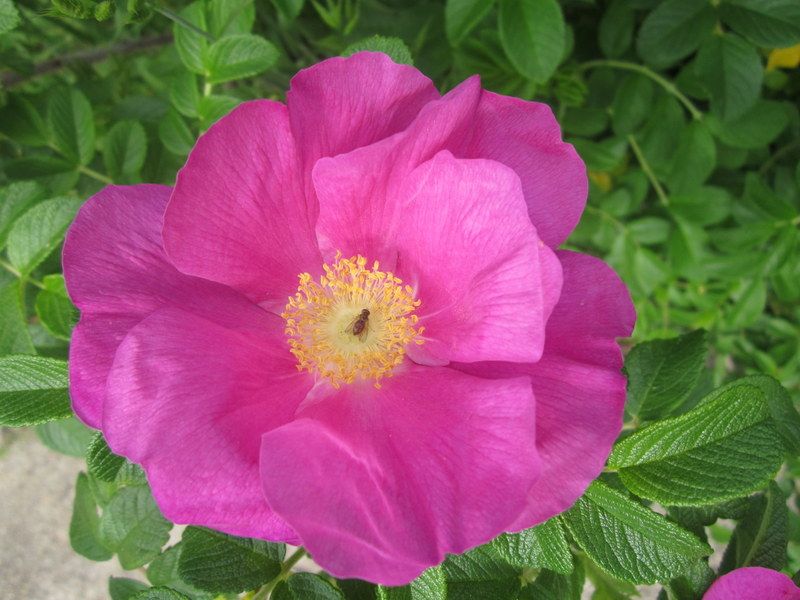
Photo Caption: This Rosa rugosa was blooming at the permaculture home where I stayed for my first class weekend, May 18th – 19th. I generally don’t think you need much excuse to grow roses, but this pink beauty also has great hips. Roses that expose their centers are good beneficial insect attractors, too.
Then I heard about the Roots and Seeds Permaculture in Action (PIA) class in Asheville, NC. I decided to jump on their work-trade opportunity in order to get hands-on experience in an area with similar growing conditions to my own. Asheville is a colder climate than Greenville, but it has a lot more familiar elements than Australia.
Click the link to keep reading.
Our urban farm (as detailed in this recent post) already has some permaculturesque elements. However, I wanted more experience with plant guilds, earthworks, water catchment, cob building, and more. I was also becoming aware that permaculture is more than just projects.
I’ve seen so many agricultural “trends” like lasagna gardening, square foot gardening, hydroponics, intensive planting, rotational grazing, native plant gardening, and even organic gardening that I’d overlooked what permaculture really is. Projects and techniques are wonderful things, but they’re still just tools in the bigger picture. If you’re tuned in to nature it’s definitely possible to figure a lot of this out on your own… but it’s much, much faster to take a class.
Which brings me to my advice for anyone trying to decide if you “need” a permaculture class. No, you don’t. You can find out what you need to know by gleaning information from books, forums, videos, and most importantly — experience. That said, a class will speed things up. It’s amazing how quickly everything clicked into place once I had Zev Friedman and Dylan Ryals-Hamilton as my instructors… and I’ve only been to 2 PIA class weekends (4 days total) so far.
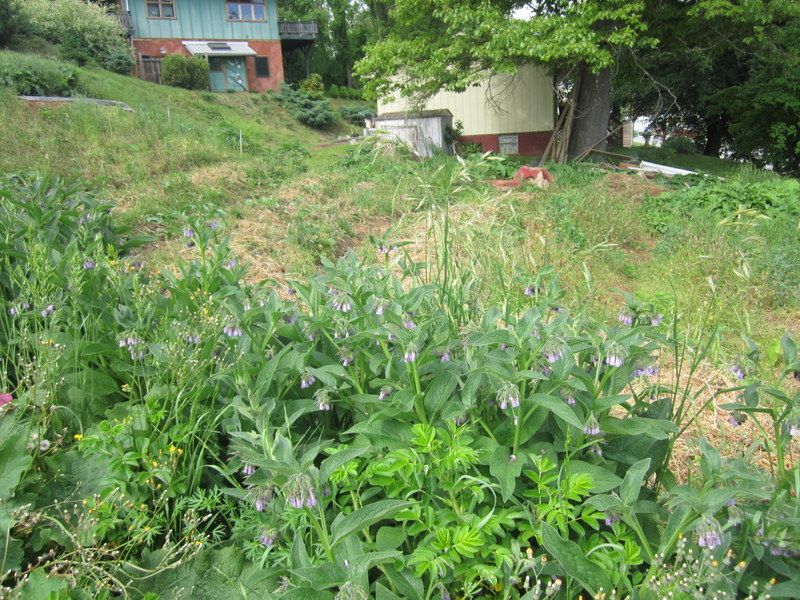
Photo Caption: Most of the large gardens in Asheville seem to involve some sort of retaining walls or terracing. Permaculture often adds water-retaining swales on contour. Potentially opportunistic (but useful) plants go on the far edges of the property.
I arranged to stay with one of the PIA class administrators for the weekend… every house should be as easy to find as a permaculturalists! One glance at all the yards on the street and I didn’t bother reading the house numbers. I wandered around her terraced milpa on Friday afternoon taking pictures and feeling surprisingly at home.
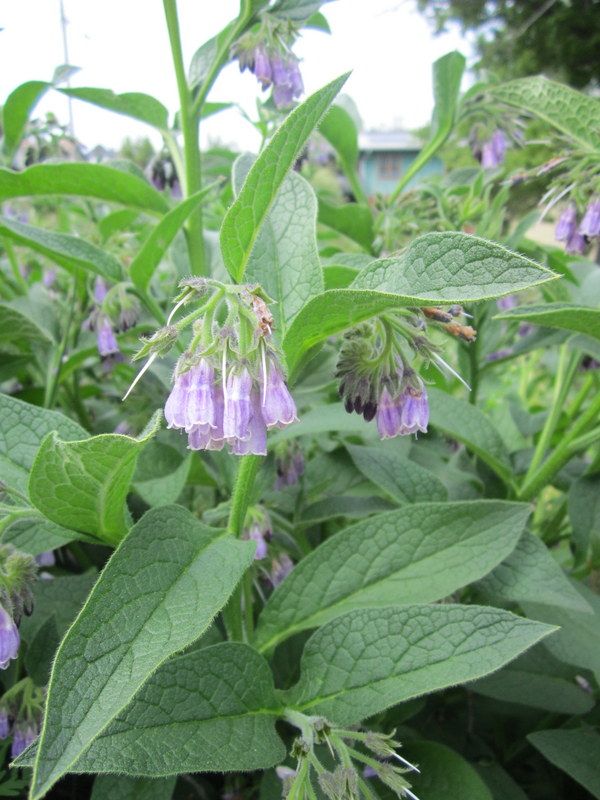
Photo Caption: I tried growing comfrey a long time ago and after killing it, assumed it couldn’t handle our hot summers. However, comfrey’s relative borage grows just fine in our yard. Now that I’m seeing it in so many Asheville gardens I think it is more likely that I didn’t invest enough effort getting it established. Comfrey is a permaculture superstar due to its nutrient accumulation abilities. It has a long tap root that sucks minerals from deep in the soil and can be cut as mulch to release that fertility in the upper topsoil layers. Herbalists use it as a medicine for a variety of ailments. I was also taught that the flowers are edible by a little girl named Evelyn.
Permaculture designs vary from place to place, but most of them contain comfrey. True comfrey tends to be preferred by herbalists, but it is an opportunistic escape artist in the garden (read: weedy as all get out). A sterile variety of Russian comfrey is available (usually as root pieces) and will not reseed all over the garden.
As you might guess, a persistent plant that is propagated by root segments is not a good candidate for a cover crop that gets tilled in. Comfrey is used for chop and drop mulching or just allowed to die back naturally each winter. Put it where you always want it since the deep taproots are not easy to get rid of.
Though I will never understand how red clover earned its common name (it’s purple), crimson clover seems fair enough. I wish we could go back in time and get the people who named hearts-a-burstin’, Jack-in-the-pulpit, and kiss-me-over-the-garden-gate to make up new names for them both, though.
Clovers are wonderful nitrogen fixing plants and beneficial insect attractors. We talk about them frequently in class. Considering where your nitrogen will come from is an important aspect of planning guilds in permaculture. If you produce a lot of manures on your property, having plants do the job may not be as vital. However, nitrogen is the most important nutrient for plant growth, and nitrogen-fixing plants interspersed through your beds ensure an ample supply in the soil.
Nitrogen-fixers use a symbiotic relationship with beneficial bacteria to fix nitrogen gas from the air into a form plants can use. During the course of a growing season, root die back releases nitrogen into the soil for other organisms and neighboring plants to use. Deciduous plants automatically do this when they die back for the winter, but you can chop and drop your nitrogen fixers in order to force a root die back combined with using the plant tops as a composting mulch.
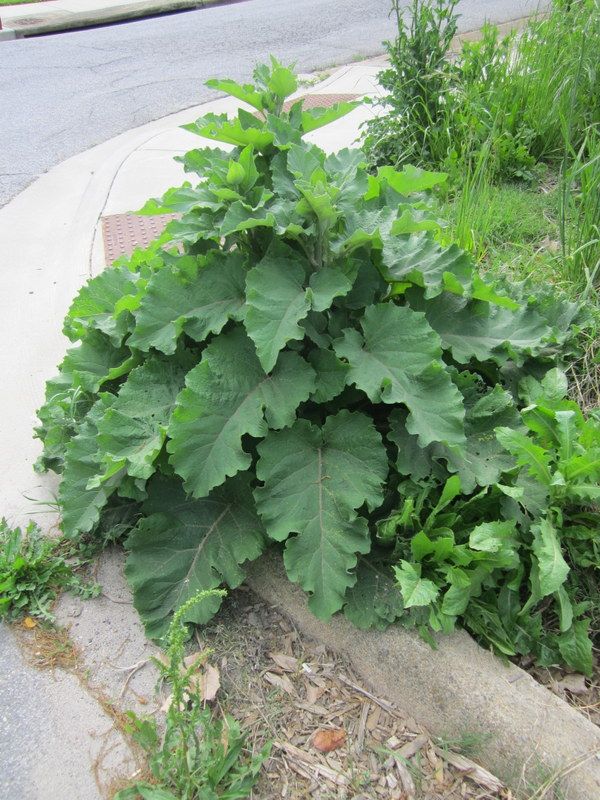
Photo Caption: Burdock is another plant I gave up on when I killed it the first time I grew it. I need to stop assuming a plant doesn’t like my climate! A lot of seeds will grow without any assistance if you just toss them on the ground in February instead of giving them tons of attention in a protected seed tray. Burdock seems to be one of them. (I often plant seeds in February so they come up when they like the weather in my area — most seed packet sowing dates are written for northern climates).
My husband and I could eat pickled gobo (burdock) all day. It has lots of culinary uses and also has deep taproots that break through soil and accumulate nutrients. I tried to grow it a long time ago in an indoor seed starting tray and assumed the failure meant they were difficult to grow. I guess even weedy things are hard to grow if you don’t give them what they like, since this plant seems to completely carpet Asheville. “What is that plant growing all over the place?” was the first thing I asked when I arrived for class.
Burdock is a biennial, and I’m told the first year plants taste the best. Presumably, eating the first year plants means they never go to seed and spread in places you don’t want them to grow.

Photo Caption: Centranthus ruber is not the same thing as valerian root, but they both get called “valerian.”
Red valerian (Centranthus ruber) was another plant I was happy to see. I’ve always liked it as a beneficial insect attractor, and I’ve just learned its leaves and roots are edible in salads. It’s not the same thing as valerian root, Valeriana officinalis.

Photo Caption: Minnie is proud to live at the permaculture home in the above photos and is the most chill little dog I ever met.
Okay, I have to admit that I wrote the above segment of this post weeks ago and then left this in my drafts folder long enough that my memory of what we covered back in May is getting fuzzy. I hope I keep up better with documenting the rest of our classes in a timely manner since it serves as a nice reminder for me to look back through this blog and read past posts.
Here’s a jaunty effort at describing our first class weekend in May, which began on Saturday with some impressive lectures and Powerpoints on the fundamentals of permaculture by Zev and Dylan (you can get your own copy of their free permaculture principles ebook). Then we migrated to the Pearson Community Garden for some additional lessons and hands-on experience.

Photo Caption: Pearson Community Garden is run by the Bountiful Garden Project. The site includes extensive food plots, a nice shelter for social activities, a small outdoor kitchen, a cob oven, a hoop house, a greenhouse, a tool shed, an apiary, a fire ring, a solar dehydrator, and a cob composting toilet.
We began the morning with a fire starting ritual (no matches or lighters) that everyone but the neighbors enjoyed (early AM chanting wasn’t the sound one man wanted to wake up to, and he let us know).
We had all been instructed to bring a small amount of wood from a tree we personally know. Instead of the familiar workshop ritual of everyone in the room introducing themselves to the group, we were asked to tell what watershed we lived on, the name of a child and elder important to us, what we feel we bring to the group, and our name, before putting our wood in the fire.
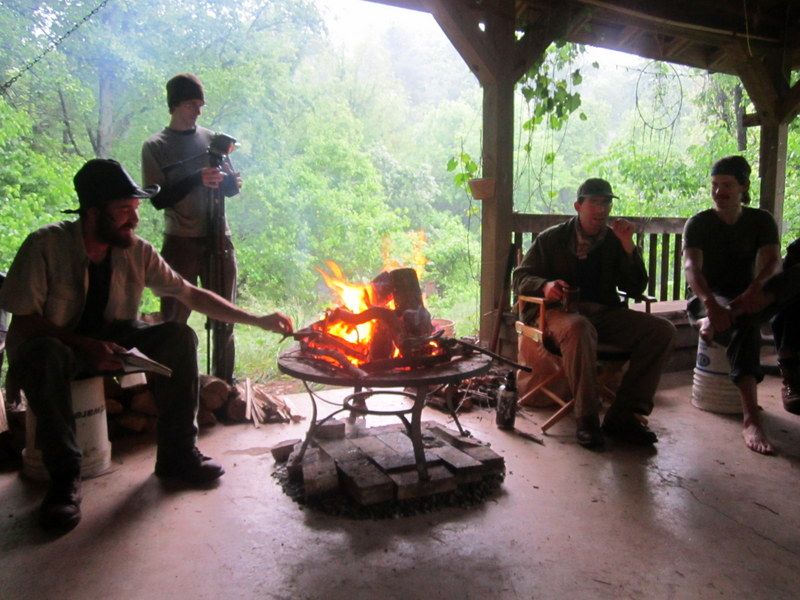
Photo Caption: Zev is sitting to the right of the fire he started from scratch and Dylan is on the left adding more fuel.
We spent the morning getting to know each other and going over the 20 principles of permaculture that are being taught to us during the class. Other permaculture classes use fewer principles but theirs are a combination of both the sets that Bill Mollison and David Holmgren invented.
When many people talk about permaculture, they like to focus on certain projects that they are doing. One of the things that is really sinking in for me during our classes is that the projects and techniques aren’t permaculture — they’re the tool box.

Photo Caption: The meeting shelter was comfortable and very welcome when it started raining. In the background, one of the apprentices is trying to thwap a pinata that was made by his fellow apprentices for his birthday. The apprentices are people who (mostly) have already taken their PDC course and are gaining experience before they go out and spread their knowledge. Each apprentice oversees a small group of PIA students (3 – 5 people) when we separate to do projects.
One of the permaculture principles is often referred to as “stack and pack” or layering. This means getting a lot of elements and uses into the same space. The shelter is an example of this because in addition to being a multi-functional meeting space, the rafters are being used to dry herbs and the roof to collect water.

Photo Caption: Hot air rises and no direct sunlight hits the space in the rafters. This makes it an ideal place for drying herbs.
Another is “utilize edges and value the marginal.” When two areas meet, their edges contain the most biodiversity and productive potential. This pawpaw is growing against the edge of the shelter in a natural espalier pattern. Espalier is a method of fruit pruning that forces the tree or shrub to grow flat against another surface.
In the case of pawpaws, they often grow this way on their own, though they spread out more as they age. The pawpaw’s shape saves space while also producing fruit and shading the shelter in the summertime. A designer might choose to preserve this pawpaw’s espaliered shape over time.
The roof is more successful at water accumulation than the cistern is at holding it, so a new plan was needed for the overflow. One of our projects was to move it up the hill and create a better path for the excess water.

Photo Caption: Rain barrels and cisterns require a plan for when they overflow or the water will collect next to building foundations or cause mosquito problems. We moved this cistern higher up the hill (behind the green trash can in the photo) so that it could also be gravity fed into the garden.
“Observe and interact” is an important permaculture principle when it comes to aggressive plants like horsetail. This is a plant that can be useful if it is contained, as in this case where it is growing in a container on top of concrete.
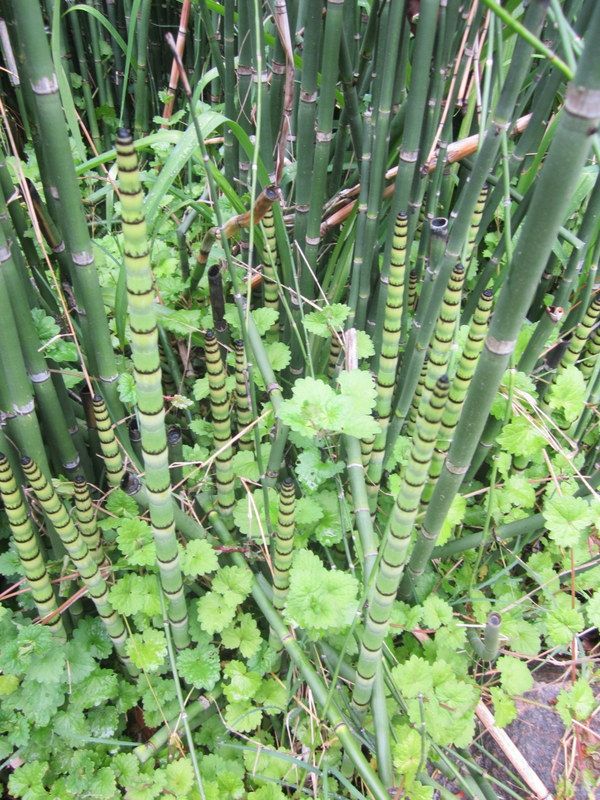
Photo Caption: Horsetail contains silica which is useful in garden remedies and for cleaning dirty dishes. The segments of the plant also pop apart like Legos.
Ponds have many uses in a permaculture context but this one appears to be largely ornamental.
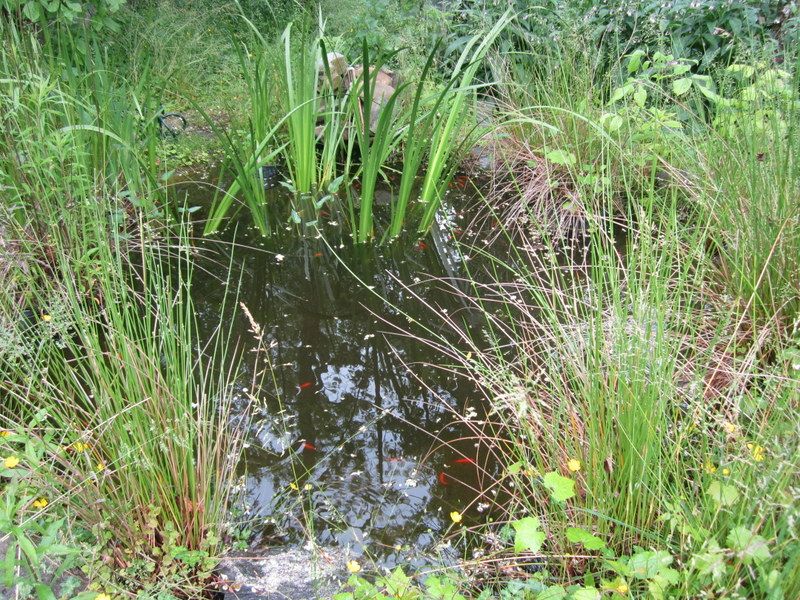
Photo Caption: This goldfish pond contains plants, but I’m not sure what their uses are. Nearby honeybees were happily using the pond edges to get close enough for a sip of water.
Black locust has a multitude of uses including rot-resistant lumber, garden stakes, thorny woven fencing, protein-rich animal fodder, nitrogen-fixing roots, honeybee nectar production, and delicious edible flowers. It’s also an excellent choice for coppicing.
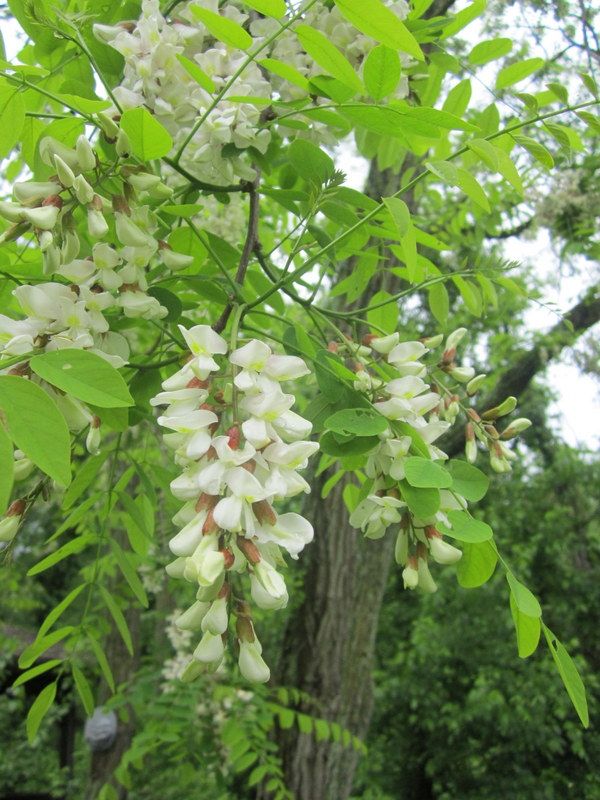
Photo Caption: Black locust flowers are crunchy and taste like jicama mixed with honeysuckle. We like them even better than the petals of our pineapple guava.
This cold frame doesn’t appear to be in use but was built using a recycled window.

Photo Caption: Cold frames with glass recycled windows should be placed where things are unlikely to fall on them. This one is positioned under some trees which may account for the broken pane of glass.
Pearson Community Garden has plenty of space to expand their permaculture plan. Each segment is being implemented in manageable phases, which means it is not finished yet.
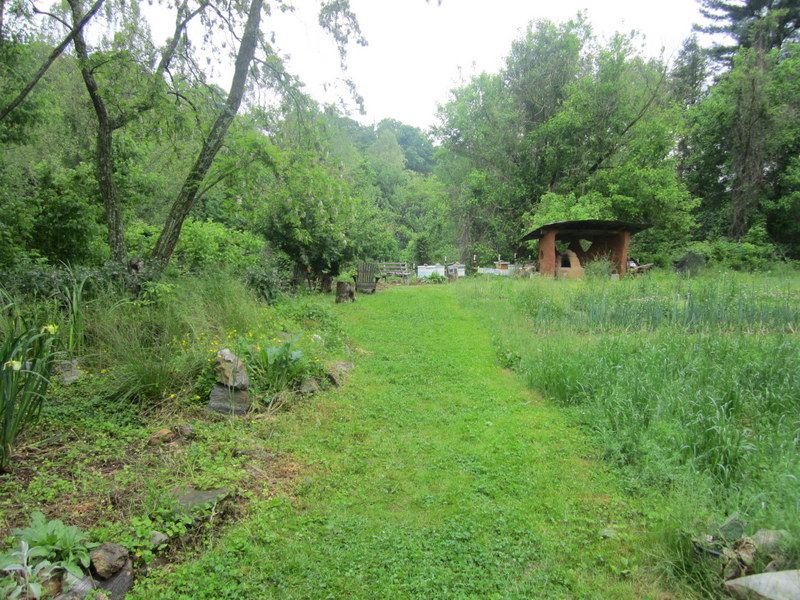
Photo Caption: The long view of the garden shows the pond and black locust on the left, the vegetable beds on the right, and the apiary and cob oven in the back. There is also an outdoor fire pit which we didn’t use due to the rain.
Beneficial insect attracting flowers were abundantly scattered throughout the landscape. California poppies are perennials but also reseed.
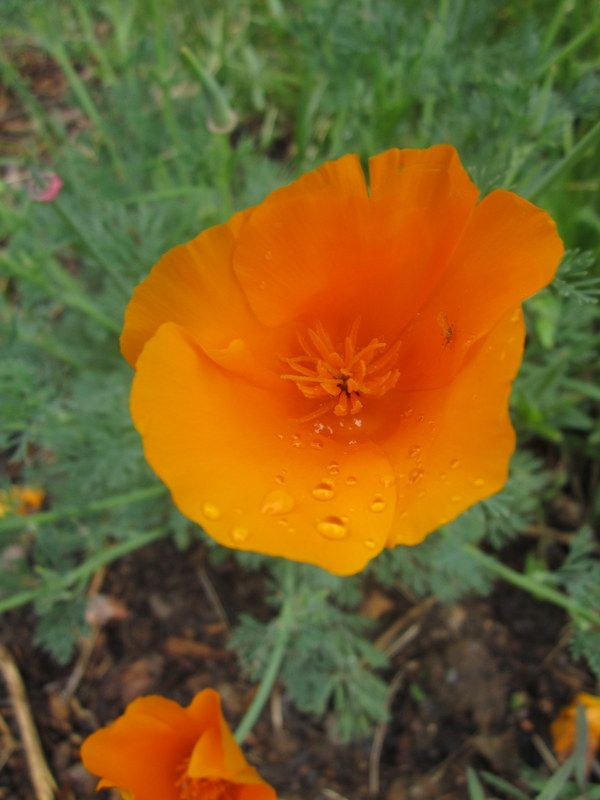
Photo Caption: California poppies are so richly colored they almost look fake. The beneficial insects love them.
Asheville area beekeepers have to keep bears in mind when placing their hives. The two most effective protectors are electric fencing or putting the apiary on a rooftop.
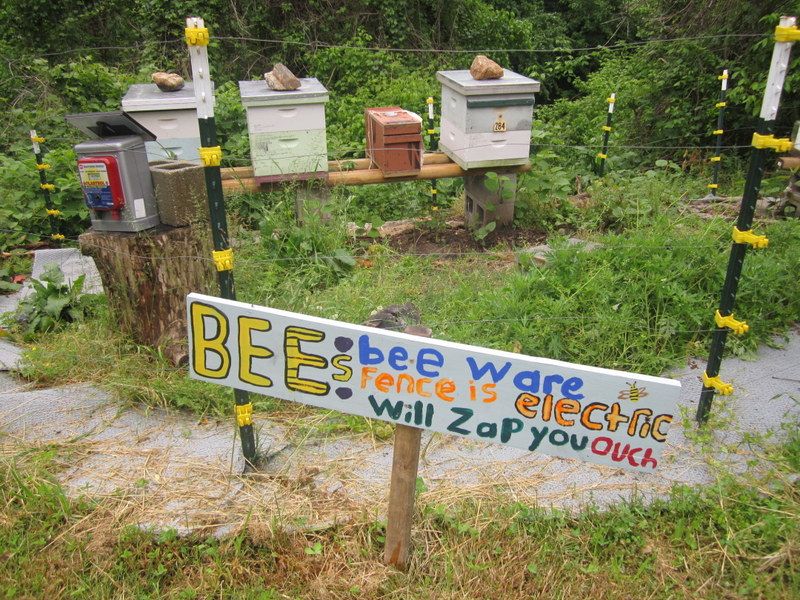
Photo Caption: Having more than one hive in your apiary produces more honey and makes beekeeping a little easier. You can compare your hives to make sure everything is normal or fix a weak hive with frames from a strong one.
Their cob oven was skep shaped, which is an old-fashioned way to build a bee hive. Honeybees live in hollow crevices and do not make this shape naturally. However, they are often confused with more aggressive yellow jackets and paper wasps, who do build similar looking homes.

Photo Caption: I hope that we do some cob building projects in our PIA class since I would love the hands-on experience.
“Use and value renewable resources and services” is commonly used permaculture principle in gardens where bamboo is used for plant supports.
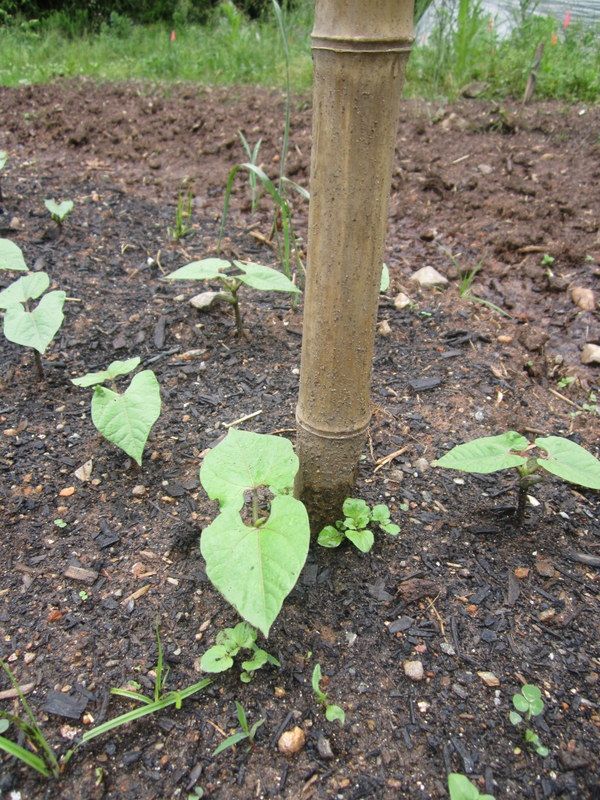
Photo Caption: Beans grow well on bamboo trellises, though it is important to let the bamboo fully die before inserting it in the ground. Otherwise, it will take root.
I have never been in a bathroom more pleasant than this cob composting toilet. It was spacious, clean, and did not smell bad. The only strong odor was of the pine sawdust used for composting.
I’m not that familiar with the uses of a living roof, other than we need to clean out our gutters soon before we start growing one by accident. Maybe it will come up during my class. I assume they lower the temperature of a building, among other things.
If I were designing it, I’m not sure I’d use a repurposed door with quite so many windows in it. Other than that, I’d be happy to replace my restroom with one.

Photo Caption: Using a composting toilet isn’t much different from a regular one. The main difference is that instead of flushing, you pour a scoop of fresh sawdust in.
The sign thanking me for my “donation” made me laugh.
The birds have found a way to compound the usefulness of one of the ventilation holes while also utilizing the toilet…
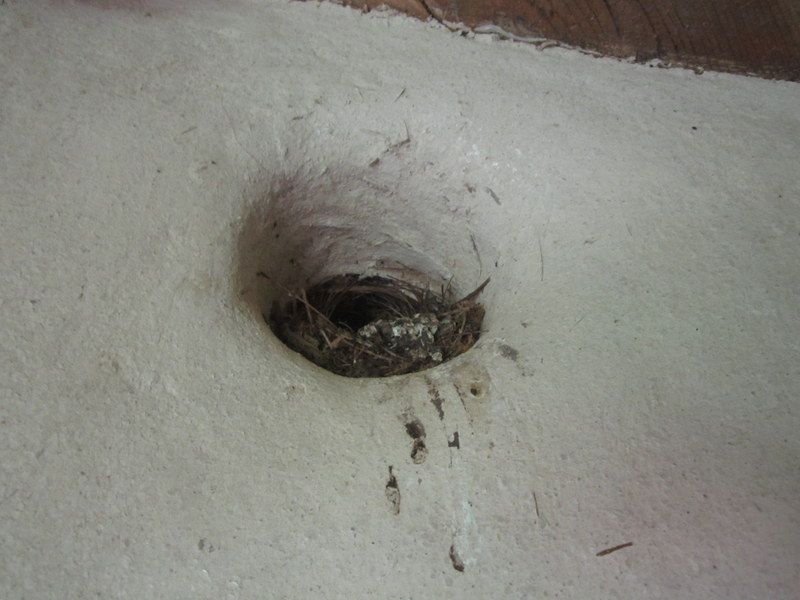
Photo Caption: The composting toilet’s ventilation holes are stacking functions as a birdhouse (and bird toilet).
Though a large segment of the vegetable beds look like a typical garden, there was an area that was full of keyhole beds and fledgling forest garden plants.
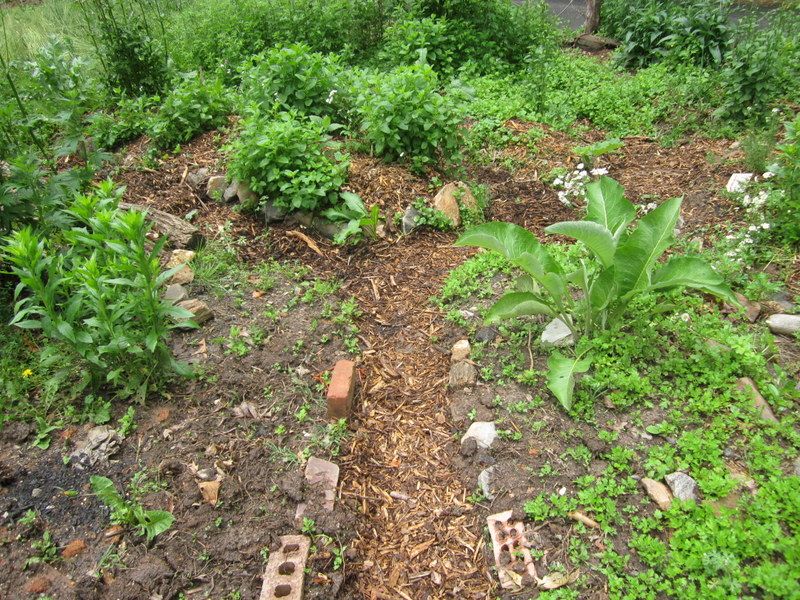
Photo Caption: Keyhole beds are named because their paths look a bit like a keyhole. This one has a brick lining to make it easy to tell the walkway from the planting area. Stepping on soil compacts it and makes it less healthy for plant roots to grow.
Many of these plants will grow to form layers that mimic the natural state of a forest. Once that happens, it is often unnecessary to bring in amendments for plants to grow. The leaf litter will sustain the soil and keep nutrients cycling through the system.
The key is to garden like a forest, not to try to grow things under already established trees. Forest gardening is a permaculture method that imitates a pattern (otherwise known as “observe and replicate natural patterns”).
Angelica is in the carrot family and has huge umbels of tiny flowers that attract beneficial insects. Unfortunately, I just missed capturing the open blossoms on camera.
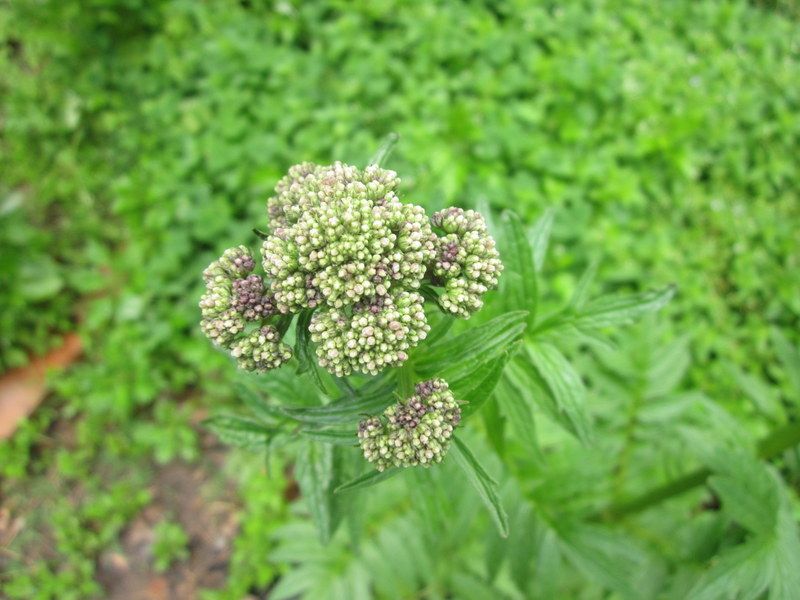
Photo Caption: Unopened angelica flower heads look a bit like broccoli but are in a different family. It also has medicinal and culinary uses.
I have no idea what this thing is. Is there anyone who can enlighten me?
I wondered if the hoop houses had been used for winter vegetables, but at the time of my class they were full of bread poppies.
Few people realize that poppy seeds (or opiate drugs) come from such a lovely plant.
If you want to grow your own poppy seeds, they are simple to harvest when the seedheads are dry.
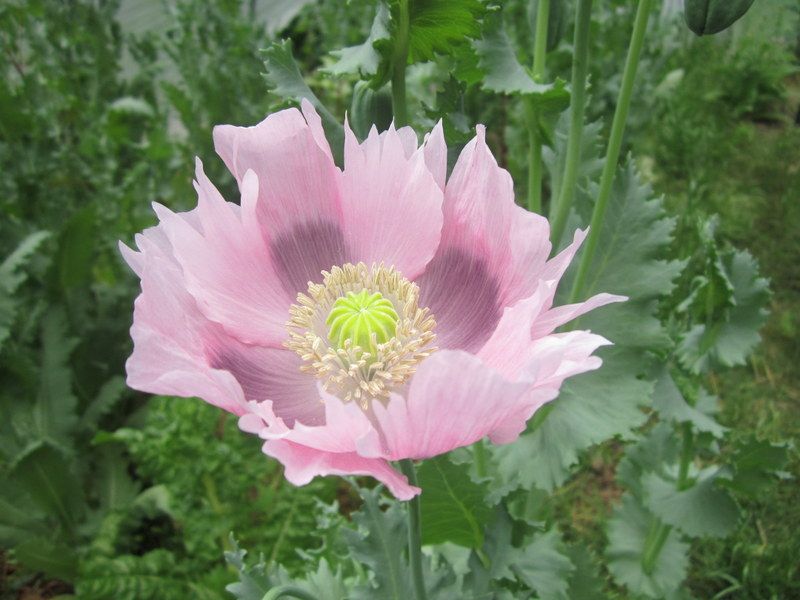
Photo Caption: Poppies rarely enjoy hot climates, though some will grow in the heat if you get them established while it is still cool out.
Comfrey is one of the most common permaculture plants for margins of the garden.

Photo Caption: Comfrey should only be planted in places it is wanted for a long time, since it is difficult to remove.
I doubt we’ll build a solar dehydrator during our class, but they are useful during big harvests. Maybe I’ll learn this at the next Organic Growers School since they usually feature a class on building them. Alternately, there are tons of DIY plans online.
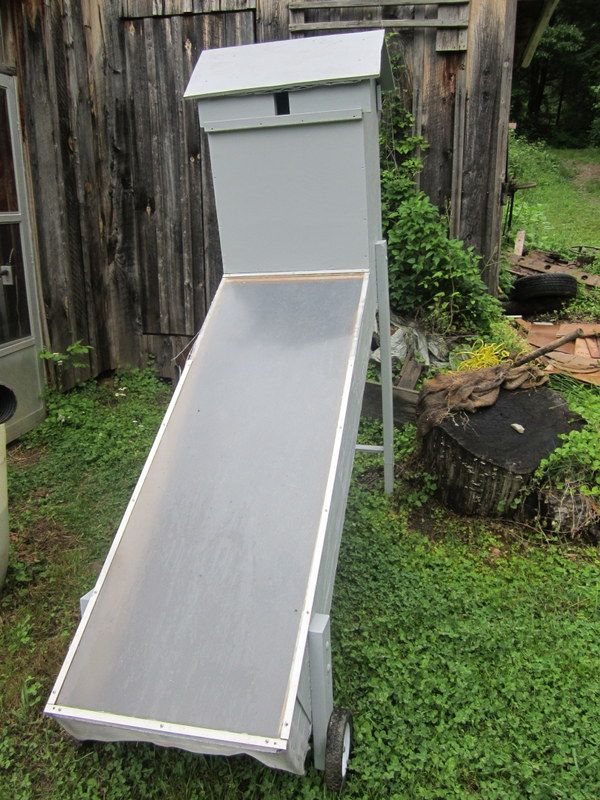
Photo Caption: A little girl visiting the garden took a lot of convincing that this solar dehydrator was not a slide she could play on.
A lot of permaculturalists swear off seed starting by growing easy perennial foods, but some still have a use for a greenhouse full of young transplants.

Photo Caption: Greenhouses make seed starting a much easier process and eliminate the need for electric lighting.
Carbohydrates and fats are two areas where permaculturalists need to really pay attention to their design. They’re the hardest to obtain from a landscape. Energy storing tubers and roots such as Jerusalem artichokes are one way to fill that need.

Photo Caption: Jerusalem artichoke patches work well because you can never harvest all the tubers. Whichever ones you miss will sprout back the following season. They also have beautiful flowers, since they are a sunflower.
The milk thistle at the Pearson Community Garden seems to have spread more than they would like. In a community garden setting, I’m not sure how to solve that problem. At home, it is a good plant to put in a place you will walk past daily. That way seed heads can be noticed and removed before they disperse. This is an example of using the permaculture principle for “sectors and zones.” Zone 0 is usually described as the interior of the home or the person residing in the home. Zone 1 is the outdoor area most trafficked by the residents (the fuzzy slipper area), zone 2 is for garden and livestock that need frequent maintenance, zone 3 is for long-term food supplies and orchards, zone 4 is for systems that can exist outside of eye and mind, zone 5 is for wilderness, and zone 6 is usually the area outside the property.
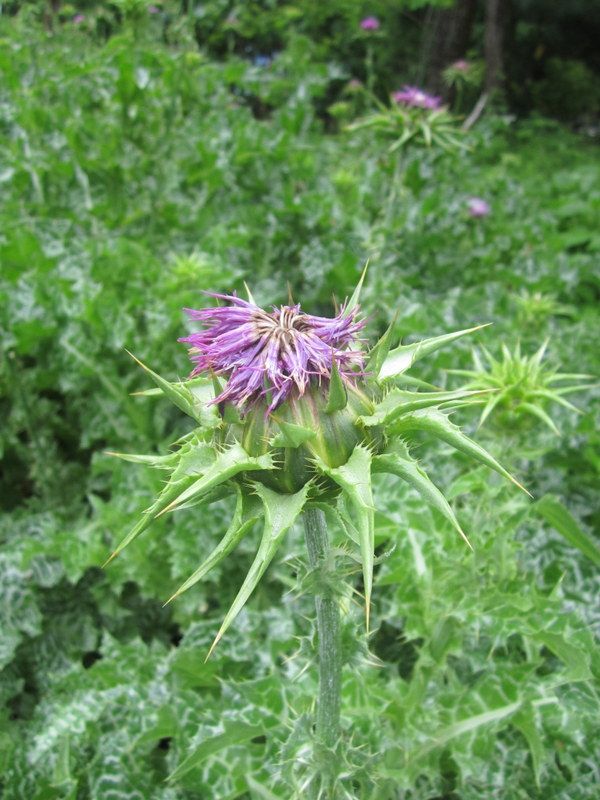
Photo Caption: I killed the milk thistle I grew from seed this year, which my daughter wanted for her herbal medicine projects. Maybe I can bum some seeds from the Pearson Community Garden, who seem to have an abundance.
One project everyone enjoyed was edible mushroom inoculation. PIA provided spawn for oyster mushrooms, elm oysters (which aren’t true oyster mushrooms), and king stropharia which was mixed with sterilized coffee grounds. Everyone got to pack mushroom spawn into cardboard egg containers to take home with them, and the remains were added to the garden mulch.
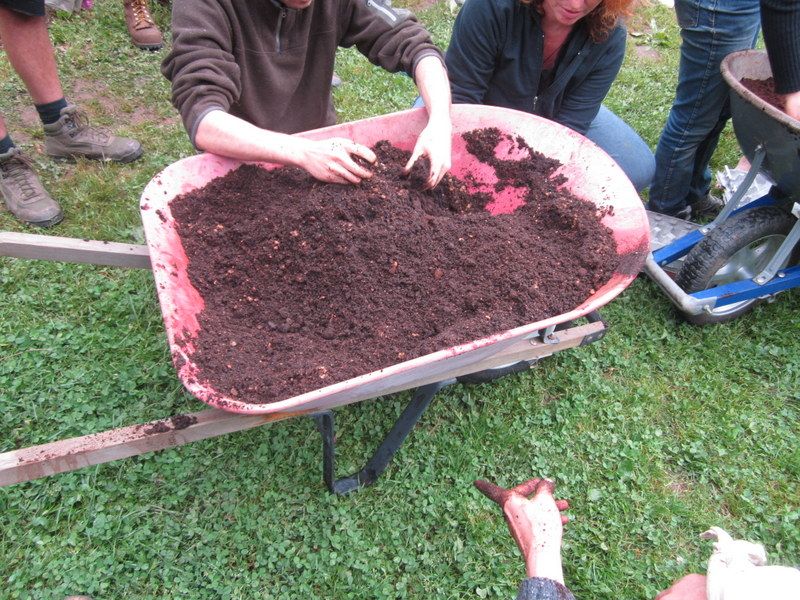
Photo Caption: Oyster mushrooms grow very well on old coffee grounds, though you don’t need an entire wheelbarrow full.
Another project was learning to make cordage from natural fibers. We used yucca, which is supposed to be exceptionally strong. We were instructed to hang on to our cordage in order to use it again at a later date.
My photography during that class day was spotty due to how much rainfall we were getting. Our apprentices led small groups to complete a hugelkultur project in the back of the property near the cob oven, a French drain behind the hoop house, and the previously mentioned water catchment project that involved moving the giant cistern (though I understand that part of it didn’t function properly and had to be reworked after the class).
Each evening, I walked to a restaurant in the River Arts District of Asheville called Pizza Pura, which I recommend.
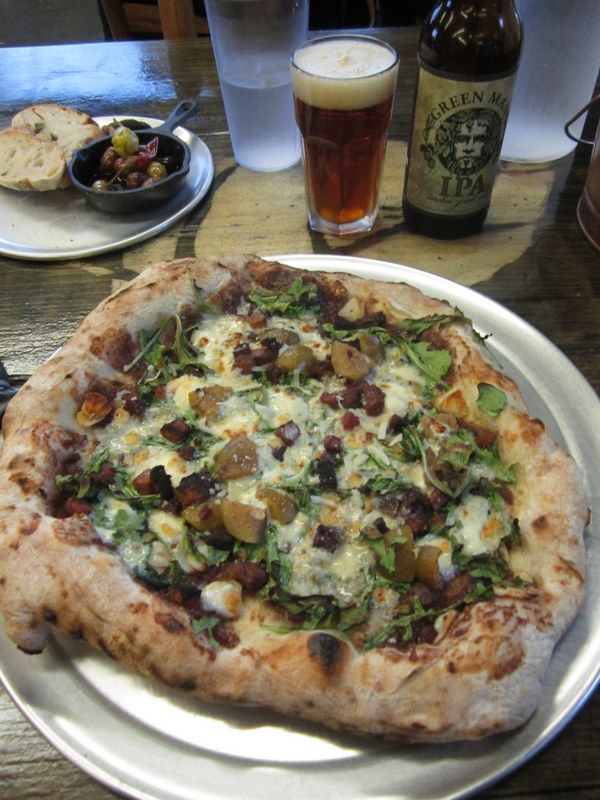
Photo Caption: This is the olive appetizer (which comes warm in a little skillet), a Green Man IPA, and the “fig and pig” pizza which involves figs, Gorgonzola cheese, and pancetta.
The next day we met at the Haywood Street Congregation’s Loaves and Fishes Community Garden. Our primary purpose was for a long day of Powerpoint presentations and lectures, including one on forest gardening.
The garden itself is designed to look like a fish (from a bird’s eye view). Like most gardens in Asheville, it has to deal with steep slopes.
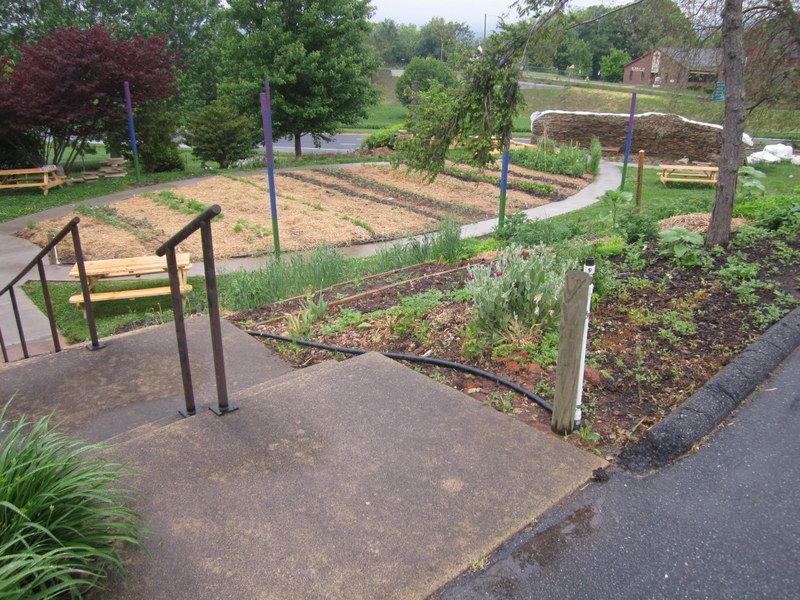
Photo Caption: We returned to this garden on a sunnier day for our second class weekend and put in garden terraces with contoured swales and a new sheet mulched garden bed.
Perhaps they need a dovecote, since there is already a local population of squab. I’ve been excited about doves ever since Chuck Marsh mentioned them at the Organic Growers School a few years back as one solution to peak phosphorus. The pigeons leave the dovecote during the day and collect wild food that they then process into phosphorus rich manure and meat.
The ornamental alliums on the property were beautiful but already past their most useful stage for beneficial insects. If you look carefully, you’ll see the swelling green center in each flower. This is where the seeds are forming and means the plant is no longer producing nectar to attract pollinators.
It’s important to make sure there are always nectar producing flowers like this in a permaculture garden.
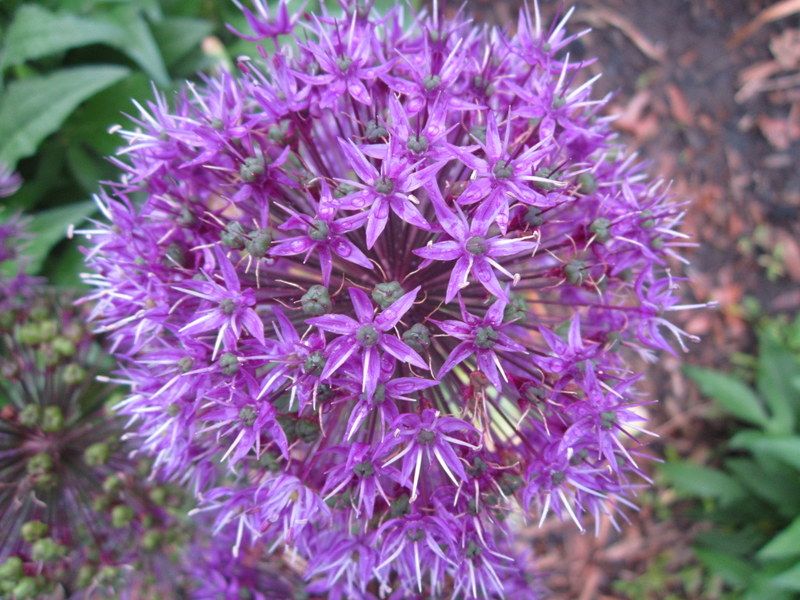
Photo Caption: Members of the allium, or onion, family are great beneficial insect attractors while they are producing nectar.
The next photo shows a seed head that has dropped its petals.
I took almost no photos at all for our 2nd weekend of class in early June. Again, this was due to heavy rain. It got so intense that we actually broke for rain activities during most of the weekend, which meant a lot of indoor class time. We made mead and honed our permaculture principles.
One of the more interesting activities was a permaculture forum that was open for the public to attend. A panel of experts fielded questions from citizens on how to use and spread permaculture ideas throughout the world… though primarily in the city of Asheville. Asheville happens to be a transition town.
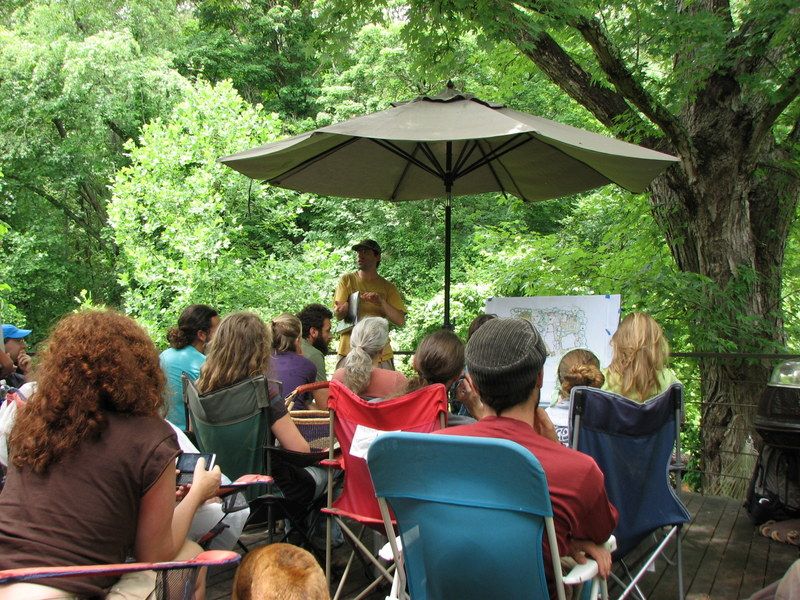
Photo Caption: We attempted to go over the permaculture plan for this property in the rain, but it got too intense to continue. This property became one of our focuses during the 3rd class weekend, which I will write about later with plenty of rain-free before and after photos.
Some of the most useful lessons I’ve taken from the class so far involve staying conscious that people are integral parts of a permaculture system. After all, the primary permaculture ethics are earth care, people care, and fair share. I tend to stay wrapped up in the earth care and fair share details and take the people for granted. I definitely need to put more thought into how to nurture that part.
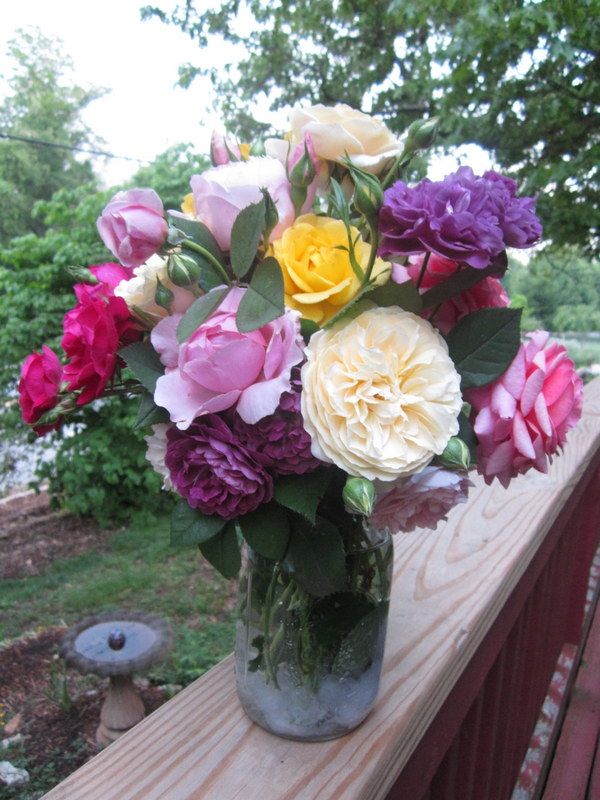
Photo Caption: I brought these roses from home to put on the refreshment table the first day of class.
Toby Hemenway wrote this article on The Myth of Self-Reliance. Permaculture is not about running off on your own and producing everything you need on your own land. It’s about learning to be part of a bigger system while designing your small section of it. I’m hoping the two classes I’m taking help me learn how to do that more effectively.
3 thoughts on “How to Learn About Permaculture”
Comments are closed.

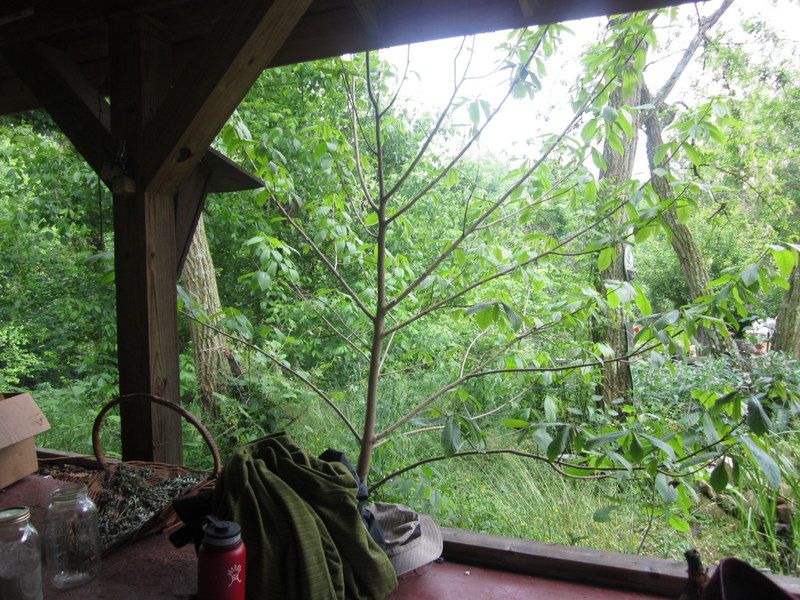

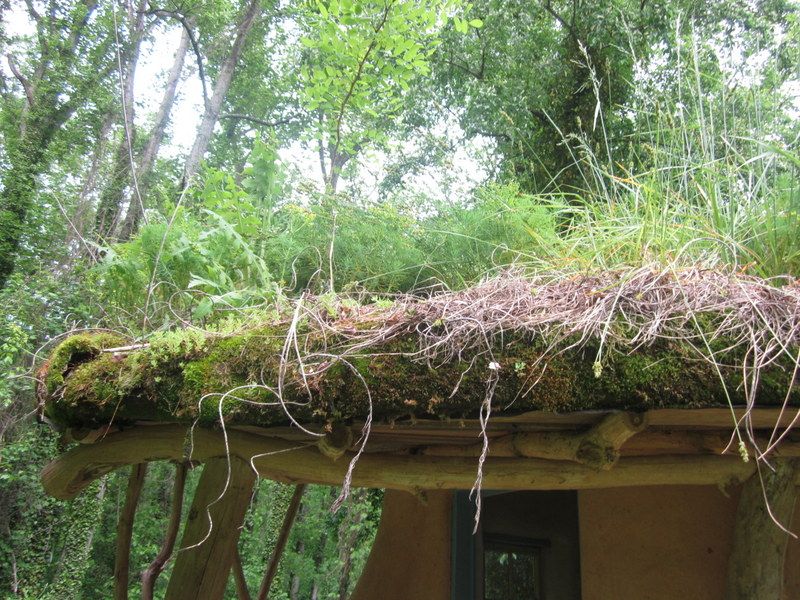
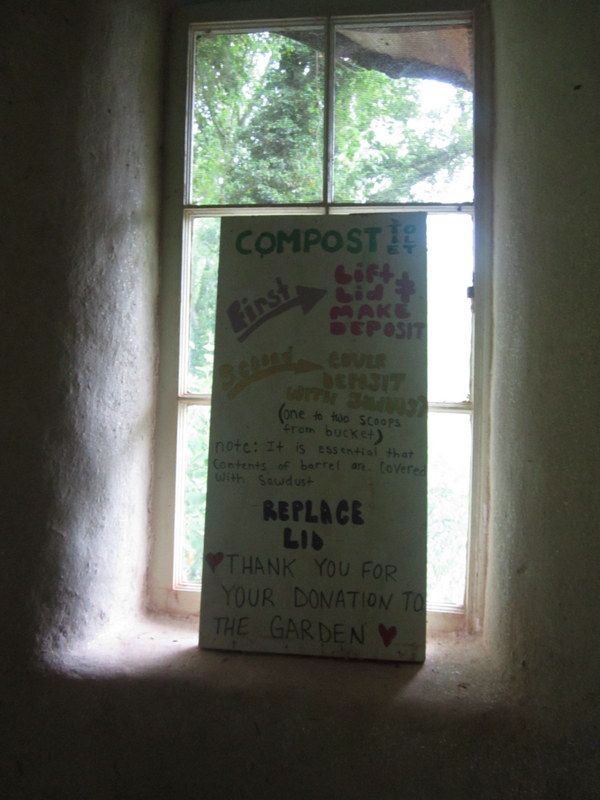
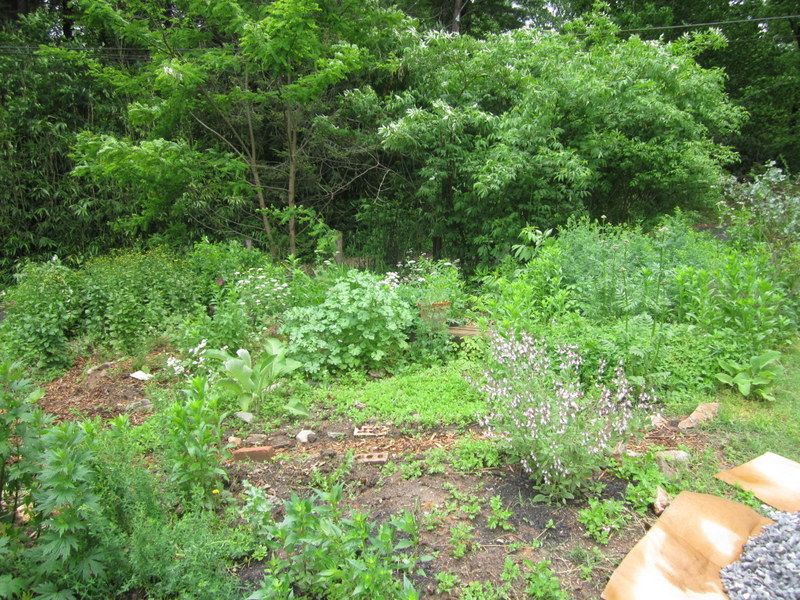



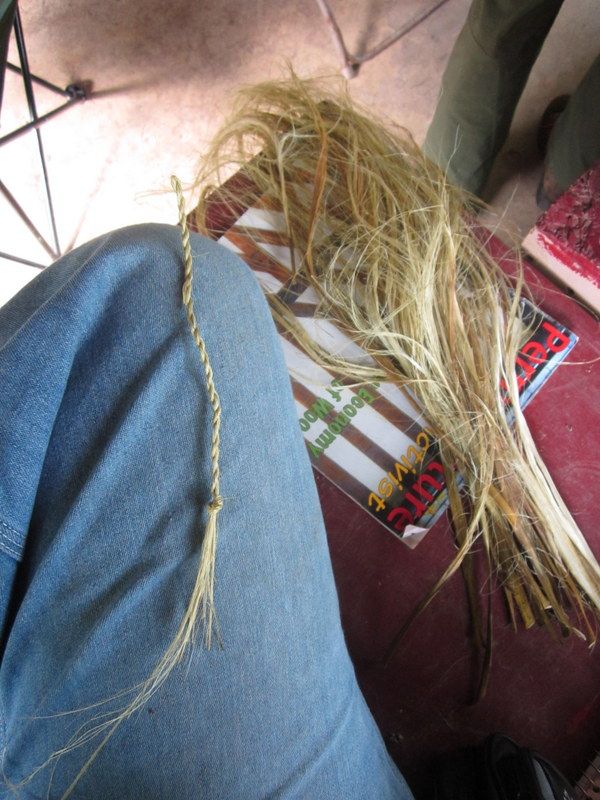
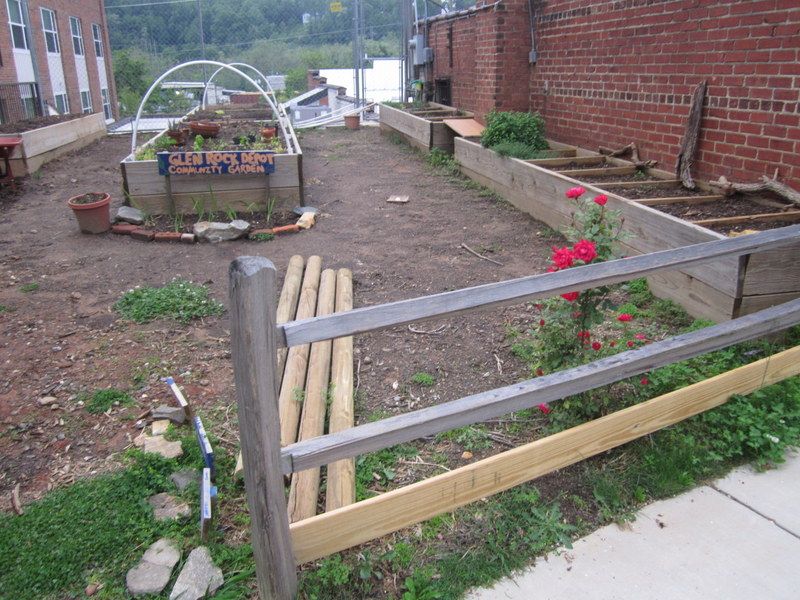
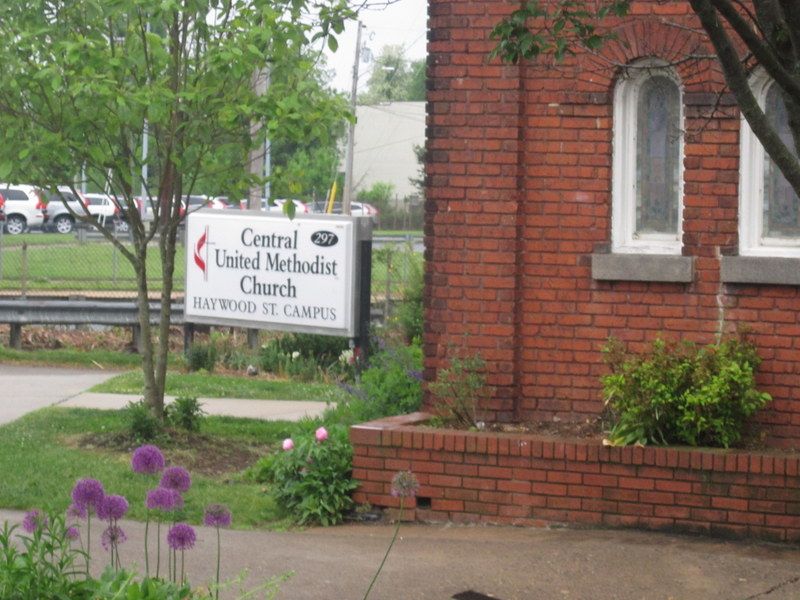



John Athayde - June 17, 2013 9:40 pm
That pyramid thing that you couldn’t identify is actually a planter. You fill the center with soil and then plant into the outside areas. Lots of vertical production in a small footprint.
PlantPostings
Twitter: plantpostings
- June 17, 2013 10:15 pm
Wow, where do I start. First, you’ve convinced me I need to either take a class or become more educated about permaculture. Some of these concepts aren’t new to me, but there’s SO much more to learn! One of the major points covered in our master naturalist courses was what you mentioned about the biodiversity of areas where two systems (climates, plant communities, ecosystems) meet. There’s an area that slashes through the middle of my state where that happens, and I’m sure that’s true in most states. Also, when an Oak opening meets a forest, or a prairie meets a marsh, etc., the biodiversity is fascinating. Thanks for this most informative post!
PlantPostings´s last blog post ..Perfect June blooms and foliage
Damaria Senne - December 7, 2013 10:00 am
Very interesting. I know I need a class; one with plants geared to my area and climate (Southern Hemisphere).